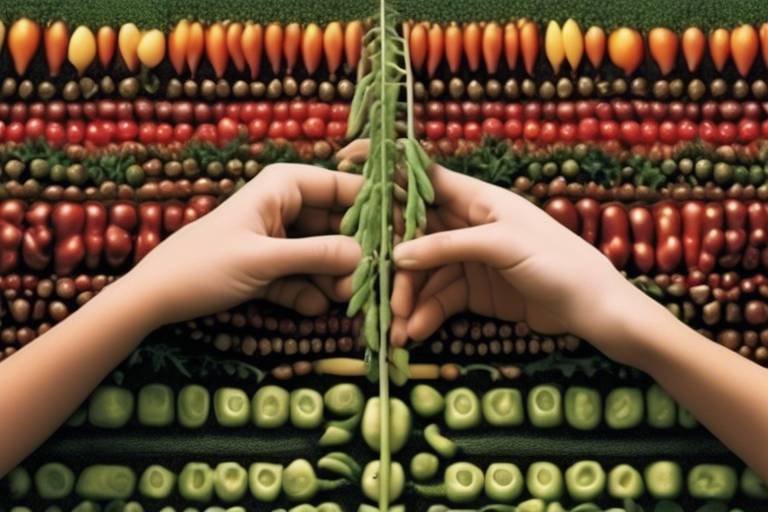Exploring the Role of Genetics in Agriculture
The world of agriculture is undergoing a remarkable transformation, and at the heart of this evolution lies the fascinating field of genetics. Understanding how genetics influences agricultural practices is not just for scientists in lab coats; it’s vital for farmers, consumers, and anyone interested in the future of food. As we dive into this topic, we’ll uncover how genetics plays a pivotal role in enhancing crop yields, increasing pest resistance, and promoting sustainability. It’s like having a secret weapon in the fight against food scarcity and environmental challenges!
Imagine walking through a field of vibrant crops, each plant a testament to the power of genetic innovation. These advancements are not merely about producing more food; they’re about creating a sustainable future where agriculture can thrive despite the pressures of climate change, population growth, and dwindling natural resources. But what exactly does this mean? Let’s break it down.
At its core, agricultural genetics involves the manipulation of an organism's DNA to achieve desired traits. This can mean anything from making plants more resistant to diseases to enhancing their nutritional value. As we explore the intricacies of genetics in agriculture, we’ll also highlight the innovative techniques that are shaping the future of farming. From CRISPR technology to traditional breeding methods, the toolbox available to farmers has never been more sophisticated.
But why should we care about these advancements? In a world where food security is becoming increasingly precarious, understanding and implementing genetic techniques can be the key to feeding a growing population while also protecting our planet. Join us as we delve deeper into the significance of genetics in agriculture and discover how it can lead to a more sustainable and productive future.
Understanding the fundamental principles of genetics is crucial for grasping its application in agriculture. At the most basic level, genetics is the study of heredity and the variation of inherited characteristics. This involves DNA, the molecule that carries the genetic instructions for life, and genes, the segments of DNA that determine specific traits in organisms.
In agriculture, the manipulation of these genes can lead to significant changes in plant traits. For example, through selective breeding, farmers have been able to enhance traits such as drought resistance, pest resistance, and overall yield. It's like being a conductor of an orchestra, where each gene plays a note that contributes to the harmony of the final product—our crops!
As we venture further into the realm of agricultural genetics, it’s essential to explore the various genetic modification techniques available today. These methods are designed to improve crop resilience, nutritional value, and productivity. While traditional breeding has its merits, modern techniques like CRISPR have revolutionized the field.
CRISPR technology, which stands for Clustered Regularly Interspaced Short Palindromic Repeats, has taken genetic engineering to a whole new level. It allows scientists to make precise edits to DNA, enabling the development of crops that are not only more resilient to diseases but also more efficient in their growth. Think of it as a super precise pair of scissors that can snip away unwanted traits while enhancing desirable ones.
The benefits of using CRISPR in agriculture are numerous and impactful. Here are a few:
- Reduced pesticide use: By developing disease-resistant crops, farmers can rely less on chemical pesticides, which is better for the environment.
- Increased crop yields: Enhanced growth and resilience lead to higher productivity, ensuring that more food is available to meet global demands.
- Improved nutritional value: Genetic modifications can boost the nutritional content of crops, contributing to better health outcomes for consumers.
Despite its advantages, the implementation of CRISPR technology is not without challenges. Regulatory hurdles, public perception, and ethical considerations play significant roles in how quickly these innovations can be adopted. Addressing these issues is crucial for the widespread acceptance and success of CRISPR in agriculture.
While modern techniques like CRISPR are making headlines, it’s important to remember that traditional breeding methods have been the backbone of agricultural genetics for centuries. Techniques such as selective breeding and hybridization have proven effective in enhancing crop traits. However, they often require more time and may not achieve the same level of precision as modern methods.
The advancements in genetics have had a profound impact on crop yields. Improved varieties contribute significantly to food production, which is essential for meeting the demands of a growing global population. By harnessing the power of genetics, we can ensure that agriculture keeps pace with the increasing need for food.
To illustrate the impact of genetic advancements, let's look at some case studies of successful high-yield crop varieties. These examples showcase the development processes and the positive effects on agricultural productivity:
| Crop Variety | Development Method | Impact on Yield |
|---|---|---|
| Golden Rice | Genetic Engineering | Enhanced Vitamin A content, improved health outcomes |
| Bt Cotton | Transgenic Breeding | Reduced pesticide use, increased profitability for farmers |
| High-Yield Wheat | Traditional Breeding | Significant yield increase in various regions |
The future of agricultural genetics is bright, filled with promising advancements that could further enhance crop performance and sustainability. Emerging trends and technologies, such as gene editing and biotechnological innovations, hold the potential to revolutionize the way we approach food production. As we continue to explore and innovate, the possibilities are endless.
Q1: What is genetic modification?
Genetic modification involves altering the DNA of an organism to achieve desired traits, such as increased resistance to pests or improved nutritional content.
Q2: How does CRISPR work?
CRISPR technology allows scientists to make precise edits to an organism's DNA, enabling the development of crops that are more resilient and productive.
Q3: What are the benefits of genetically modified crops?
Genetically modified crops can lead to reduced pesticide use, increased yields, and improved nutritional value, contributing to food security.
Q4: Are there any risks associated with genetic modification?
While genetic modification has many benefits, it also raises concerns regarding environmental impacts, regulatory challenges, and ethical considerations.

The Basics of Agricultural Genetics
Understanding the fundamental principles of genetics is crucial for grasping its application in agriculture. At its core, genetics is the study of heredity and the variation of inherited characteristics. In agricultural contexts, this translates to how traits in plants—like yield, disease resistance, and drought tolerance—are passed down from one generation to the next. The building blocks of genetics are DNA (deoxyribonucleic acid) and genes, which are segments of DNA that code for specific traits. Think of DNA as the blueprint of a plant, containing all the instructions needed for its growth and development.
To put it simply, if you've ever wondered why some crops thrive while others struggle, the answer often lies in their genetic makeup. The traits that determine a plant's success in a given environment can be traced back to its genes. For instance, a particular variety of corn may be bred for its ability to resist pests, while another might be developed for its high yield. This intentional selection process is where the magic of agricultural genetics comes into play.
Moreover, the science of genetics isn't just about understanding existing traits; it's also about manipulating them. With advances in technology, scientists can now identify specific genes responsible for desirable traits and work to enhance them. This brings us to the exciting world of genetic modification, where traditional breeding techniques meet cutting-edge science. By utilizing methods such as marker-assisted selection and genome sequencing, researchers are able to expedite the breeding process, making it possible to develop new varieties that are not only more productive but also more resilient to climate change and pests.
For those new to agricultural genetics, here are a few key concepts to keep in mind:
- Phenotype: The observable characteristics of a plant, such as height, color, and yield.
- Genotype: The genetic constitution of a plant, which determines its potential traits.
- Alleles: Different forms of a gene that can exist at a specific locus in the genome.
In summary, the basics of agricultural genetics provide a foundation for understanding how we can improve crop performance and sustainability through scientific advancements. By unlocking the secrets of plant DNA, we can not only enhance food production but also ensure that agriculture can adapt to the challenges of the future.

Genetic Modification Techniques
Genetic modification techniques have become a cornerstone of modern agriculture, enabling farmers to cultivate crops that are not only more resilient but also more nutritious. These techniques can be broadly categorized into two main approaches: traditional breeding methods and advanced genetic engineering technologies. While traditional breeding involves the selection of plants with desirable traits over generations, modern techniques like CRISPR and transgenic methods allow for more precise alterations at the genetic level.
One of the most exciting advancements in this field is CRISPR technology. This revolutionary tool allows scientists to edit genes with remarkable accuracy, making it possible to enhance specific traits in crops. For instance, researchers can target genes responsible for pest resistance, enabling the development of plants that can thrive without heavy pesticide use. This not only benefits the environment but also reduces costs for farmers, paving the way for sustainable agriculture.
Additionally, traditional breeding methods still play a vital role in agriculture. Techniques like selective breeding and hybridization have been practiced for centuries, and they continue to produce high-yield and resilient crop varieties. However, these methods can be time-consuming and may take many years to achieve significant improvements. In contrast, genetic engineering can deliver results in a fraction of the time, allowing for quicker responses to emerging agricultural challenges.
To illustrate the differences between these approaches, consider the following table:
| Technique | Timeframe | Precision | Examples |
|---|---|---|---|
| Traditional Breeding | Years to decades | Low | Selective breeding of corn, hybridization of tomatoes |
| CRISPR Technology | Months to a few years | High | Editing genes for drought resistance, enhancing nutritional content |
| Transgenic Methods | Months to a few years | Medium | Bt cotton, Roundup Ready soybeans |
Moreover, the potential benefits of genetic modification techniques extend beyond just crop yields. For instance, crops engineered to be more resistant to diseases can significantly reduce the reliance on chemical pesticides, which is a win-win for both farmers and the environment. This leads to healthier ecosystems and promotes biodiversity. However, it's important to note that the implementation of these technologies is not without challenges.
Public perception plays a significant role in the adoption of genetically modified organisms (GMOs). Many consumers are still wary of GMOs due to concerns about safety, ethics, and environmental impact. Therefore, educating the public about the science behind genetic modification and its benefits is crucial for fostering acceptance. As we move forward, the dialogue surrounding these technologies must continue to evolve, ensuring that both the scientific community and the public are on the same page.
In conclusion, genetic modification techniques represent a powerful tool in the quest for sustainable agriculture. By combining traditional methods with cutting-edge technology, we can create crops that not only meet the demands of a growing population but also contribute to a healthier planet. As we explore the potential of these techniques, it’s essential to balance innovation with public understanding and ethical considerations.
- What is genetic modification? Genetic modification involves altering the genetic makeup of an organism to achieve desired traits.
- How does CRISPR work? CRISPR allows for precise edits to DNA, enabling scientists to modify specific genes responsible for certain traits.
- Are genetically modified crops safe to eat? Extensive research and regulatory assessments have shown that GMOs are safe for consumption.
- What are the environmental benefits of genetic modification? Genetically modified crops can reduce the need for pesticides and herbicides, leading to less chemical runoff and improved biodiversity.

CRISPR Technology
has emerged as a groundbreaking tool in the field of genetic engineering, transforming how we approach agricultural challenges. Imagine being able to edit the genetic code of a plant as easily as you would edit a document on your computer. This is the power of CRISPR, short for "Clustered Regularly Interspaced Short Palindromic Repeats." It enables scientists to make precise changes to the DNA of organisms, leading to significant advancements in crop resilience and productivity.
The way CRISPR works is akin to a molecular scissors that can cut DNA at specific locations. This precision allows researchers to delete, add, or alter sections of the DNA sequence, effectively customizing plants to enhance desirable traits. For instance, if a particular crop is susceptible to a devastating disease, scientists can use CRISPR to edit the genes responsible for that vulnerability, creating a disease-resistant variety. The implications of this technology are enormous, promising to boost agricultural efficiency and sustainability.
One of the most exciting aspects of CRISPR technology is its potential to address pressing global issues such as food security and climate change. With the world population expected to reach nearly 10 billion by 2050, the demand for food will skyrocket. CRISPR can help meet this demand by developing crops that require fewer resources, such as water and fertilizers, while also increasing yields. For example, researchers have successfully used CRISPR to create crops that can thrive in harsh conditions, such as drought or high salinity, thus expanding the regions where agriculture can flourish.
However, the application of CRISPR is not without its challenges. While the technology offers immense promise, it also raises several ethical and regulatory questions. For instance, how do we ensure that CRISPR-modified crops are safe for human consumption and the environment? Regulatory bodies around the world are grappling with how to classify and manage these genetically edited organisms. Furthermore, public perception plays a crucial role in the adoption of CRISPR technology. Many consumers are still wary of genetically modified organisms (GMOs), which can hinder the acceptance of CRISPR-enhanced crops.
To navigate these challenges, it is essential to engage in transparent communication with the public and provide clear information about the benefits and safety of CRISPR technology. Education is key; by informing people about how CRISPR works and its potential to improve food security and reduce environmental impact, we can foster a more positive view of genetic engineering in agriculture.
In summary, CRISPR technology represents a revolutionary leap forward in agricultural genetics. Its ability to make precise edits to plant DNA holds the potential to create crops that are not only more resilient but also more nutritious and sustainable. As we continue to explore the possibilities of CRISPR, it is crucial to address the accompanying challenges and ensure that this powerful tool is used responsibly and effectively.

Benefits of CRISPR in Crops
The advent of CRISPR technology has ushered in a new era in agricultural genetics, offering a myriad of benefits that are reshaping how we approach crop production. One of the most significant advantages is the ability to create disease-resistant crops. By precisely editing the genes responsible for susceptibility to certain diseases, farmers can reduce their reliance on chemical pesticides, leading to healthier crops and a more sustainable farming practice. Imagine a world where crops can fend off diseases as easily as they absorb sunlight; that’s the potential CRISPR brings to the table.
Moreover, CRISPR technology enhances the nutritional value of crops. For instance, scientists can modify the genetic makeup of staple crops to increase their vitamin and mineral content, tackling malnutrition in vulnerable populations. This is particularly crucial in developing countries where food security is a pressing issue. By improving the nutritional profile of crops, CRISPR not only boosts health outcomes but also promotes economic stability in agricultural communities.
Another compelling benefit is the potential for increased crop yields. With the global population projected to reach nearly 10 billion by 2050, the demand for food is skyrocketing. CRISPR allows for the development of high-yield varieties that can produce more food per acre, thereby maximizing land use. This is essential as arable land becomes increasingly scarce. For example, a recent study showed that CRISPR-enhanced rice varieties yielded up to 30% more grain compared to traditional counterparts. Such advancements can significantly contribute to global food security.
Additionally, CRISPR can help crops adapt to climate change. By making genetic modifications that enhance drought resistance or heat tolerance, farmers can cultivate crops in regions previously deemed unsuitable for agriculture. This adaptability is crucial as climate patterns shift, threatening food production in many parts of the world. The ability to grow resilient crops in challenging environments could mean the difference between food scarcity and abundance.
In summary, the benefits of CRISPR in crops are vast and transformative. From reducing pesticide use and enhancing nutritional value to increasing yields and fostering climate resilience, CRISPR technology is a powerful tool in the quest for sustainable agriculture. However, it’s essential to navigate the challenges that accompany its implementation to fully harness its potential.
- What is CRISPR technology? CRISPR is a revolutionary gene-editing tool that allows scientists to make precise changes to DNA, enhancing crops' resistance to diseases and improving their nutritional value.
- How does CRISPR improve crop yields? By modifying genes associated with growth and resilience, CRISPR enables the development of high-yield crop varieties that can produce more food per acre.
- Are CRISPR crops safe to eat? Yes, extensive research and regulatory assessments ensure that CRISPR-modified crops are safe for human consumption, similar to traditionally bred crops.
- Can CRISPR help with climate change? Absolutely! CRISPR can create crops that are more tolerant to drought and extreme temperatures, making agriculture more resilient to climate change impacts.

Challenges of Implementing CRISPR
While CRISPR technology presents an exciting frontier in agricultural genetics, its implementation is not without hurdles. One of the primary challenges is navigating the **regulatory landscape**. Different countries have varying regulations regarding genetically modified organisms (GMOs), and the lack of a unified framework can create confusion and delays. For instance, in the United States, the regulatory process is often seen as more lenient compared to the European Union, where stricter guidelines can hinder innovation.
Moreover, public perception plays a crucial role in the adoption of CRISPR technology. Many consumers are still wary of GMOs, associating them with potential health risks or environmental concerns. This skepticism can lead to resistance against products developed using CRISPR, even if scientific evidence supports their safety and efficacy. To combat this, transparent communication about the benefits and safety of CRISPR-enhanced crops is essential. The agricultural community must engage with the public, providing education and addressing misconceptions.
Another significant challenge is the **ethical considerations** surrounding genetic modification. Questions arise about the long-term effects on ecosystems and biodiversity. For example, if a disease-resistant crop dominates a region, it could outcompete native plants, leading to unforeseen ecological consequences. This raises the question: how do we balance innovation with environmental stewardship? The agricultural sector must tread carefully, ensuring that the benefits of CRISPR do not come at the cost of ecological integrity.
Furthermore, the technical aspects of CRISPR implementation can be daunting. While the technology allows for precise edits, unintended consequences, known as off-target effects, can occur. These unintentional changes can introduce new traits that may not be desirable. Therefore, extensive testing and validation are necessary to ensure that CRISPR-modified crops are safe and effective before they reach the market.
In summary, while CRISPR holds immense potential for transforming agriculture, addressing these challenges is vital for its successful implementation. By fostering collaboration between scientists, regulators, and the public, we can pave the way for a future where CRISPR technology enhances food security and sustainability without compromising safety or ethics.
- What is CRISPR technology?
CRISPR is a revolutionary gene-editing technology that allows scientists to make precise changes to DNA, enabling the development of crops with desirable traits such as disease resistance and improved yield.
- Are CRISPR-modified crops safe to eat?
Yes, extensive research and regulatory assessments are conducted to ensure the safety of CRISPR-modified crops before they are approved for consumption.
- What are the benefits of using CRISPR in agriculture?
CRISPR can enhance crop resilience, increase yields, reduce pesticide use, and improve nutritional value, contributing to food security and sustainability.
- What are the ethical concerns regarding CRISPR?
Ethical concerns include the potential impact on biodiversity, long-term ecological consequences, and the need for responsible stewardship of genetic technologies.

Traditional Breeding Methods
When we talk about , we're diving into a rich history that has shaped agriculture for centuries. Farmers have been selecting plants with desirable traits—like larger fruits or better disease resistance—for generations. This process, often referred to as selective breeding, involves choosing parent plants based on their characteristics and then cross-pollinating them to produce offspring that carry those traits. It's like playing matchmaker for plants, hoping to create the perfect hybrid!
One of the most well-known traditional breeding methods is hybridization. This technique combines two different plants to create a new variety that has the best features of both parents. Imagine creating a super plant that can withstand drought while also producing juicy, sweet fruits. That’s the magic of hybridization! While these methods have been effective, they do have their limitations. For instance, the process can be time-consuming, often taking several years to develop a new variety that meets the desired traits.
Moreover, traditional breeding relies heavily on the genetic variation that already exists within the plant species. If the genetic pool is limited, the potential for improvement can be stunted. This is where modern techniques like genetic modification and CRISPR come into play, allowing us to introduce new traits more efficiently. However, it’s essential to recognize the value of traditional methods, as they have laid the groundwork for the advancements we see today.
In traditional breeding, the following principles are typically applied:
- Selection: Choosing plants with desirable traits to breed.
- Cross-Pollination: Merging genetic material from different plants.
- Evaluation: Assessing the offspring for desired characteristics over multiple generations.
While traditional methods may not be as flashy as modern genetic techniques, they are still incredibly important in the agricultural landscape. They remind us of the deep connection between farmers and the land, showcasing a time-tested approach to enhancing crop varieties. As we look to the future, it’s crucial to integrate these traditional methods with modern innovations to create a more sustainable and resilient agricultural system.
- What is traditional breeding? Traditional breeding involves selecting parent plants with desirable traits and cross-pollinating them to produce offspring with those traits.
- How long does it take to develop a new crop variety using traditional methods? It can take several years, often requiring multiple generations of plants to achieve the desired characteristics.
- What are the limitations of traditional breeding? The main limitations include a reliance on existing genetic variation and the time-consuming nature of the process.
- How do traditional methods compare to modern genetic techniques? Traditional methods are slower and depend on natural variation, while modern techniques like CRISPR allow for more precise and quicker modifications.

Impact on Crop Yields
When we think about the future of food production, the role of genetics in agriculture becomes absolutely pivotal. Imagine a world where farmers can grow more food on less land, all while using fewer resources. This isn't just a dream; it’s becoming a reality thanks to the incredible advancements in genetic research. The impact of genetic advancements on crop yields is profound, as it directly influences our ability to feed a growing global population. With the world population projected to reach nearly 10 billion by 2050, the pressure is on to boost agricultural productivity.
Genetic improvements have led to the development of high-yield crop varieties that can thrive in various environmental conditions. These varieties are not just about quantity; they also focus on quality. For instance, crops can be engineered to have enhanced nutritional profiles, providing essential vitamins and minerals that are often lacking in conventional varieties. This dual focus on yield and nutrition is crucial in combating malnutrition in many parts of the world.
To illustrate the impact of genetics on crop yields, let’s consider some key statistics. According to the Food and Agriculture Organization (FAO), genetic improvements in staple crops like rice, wheat, and maize have contributed to a significant increase in global food production. For example, the introduction of hybrid varieties of rice has led to yield increases of up to 30% in some regions. This is not just a number; it represents millions of additional tons of food that can sustain families and communities.
| Crop Type | Yield Increase (%) | Key Genetic Improvement |
|---|---|---|
| Rice | 30 | Hybrid Varieties |
| Wheat | 20 | Drought Resistance |
| Maize | 25 | Insect Resistance |
Moreover, genetic advancements have also led to the development of crops that are resilient to climate change. With unpredictable weather patterns becoming the norm, crops that can withstand drought, flooding, or extreme temperatures are essential. For instance, genetically modified drought-resistant maize has been a game-changer in regions facing water scarcity. Farmers can now grow crops even in less-than-ideal conditions, ensuring food security despite the challenges posed by climate change.
However, it’s important to recognize that while genetic advancements have significantly impacted crop yields, they are not a standalone solution. Sustainable agricultural practices must go hand in hand with these innovations. This includes responsible land management, crop rotation, and integrated pest management. The synergy between genetics and sustainable practices will ultimately lead to a more resilient agricultural system.
In conclusion, the impact of genetics on crop yields is a testament to human ingenuity and the potential for science to address pressing global challenges. As we continue to innovate and improve our agricultural practices, we must embrace these advancements while also considering the ethical implications and sustainability of our food systems. The future of agriculture is bright, and with the right approach, we can ensure a stable food supply for generations to come.
- What are high-yield crop varieties? High-yield crop varieties are genetically improved plants that produce more food per hectare compared to traditional varieties.
- How do genetic advancements help in sustainable agriculture? Genetic advancements can lead to crops that require fewer resources, such as water and pesticides, thus promoting sustainability.
- Are genetically modified crops safe to eat? Yes, numerous studies have shown that genetically modified crops are safe for consumption and can provide significant benefits to food security.
- What role does climate change play in agricultural genetics? Climate change creates challenges for traditional farming, and genetic advancements help develop crops that can withstand extreme weather conditions.

Case Studies of High-Yield Varieties
When it comes to ensuring food security and enhancing agricultural productivity, high-yield varieties (HYVs) of crops play a pivotal role. These genetically improved crops are designed to produce more grain or fruit per plant, which is essential in feeding the growing global population. Let's explore some compelling case studies that showcase the effectiveness of high-yield varieties in various regions around the world.
One of the most notable examples is the introduction of IR8 rice in the 1960s, often referred to as "Miracle Rice." Developed by the International Rice Research Institute (IRRI), IR8 was a product of crossbreeding and genetic selection. This variety was engineered to have a shorter stature and increased yield potential, which made it less susceptible to lodging during storms. Farmers in countries like India and the Philippines adopted IR8 rapidly, leading to a dramatic increase in rice production. In fact, it is estimated that IR8 alone contributed to a 20% increase in rice yields in Asia during its early years of cultivation.
Another significant case study involves high-yield maize (corn) varieties developed in the United States. The hybridization techniques used to create these varieties have resulted in maize plants that can produce up to 300 bushels per acre, compared to the traditional varieties that yield around 100 bushels. This transformation was made possible through a combination of genetic advancements and improved agricultural practices. Farmers who adopted these high-yield maize varieties reported not only increased productivity but also enhanced resilience against pests and diseases, thanks to the incorporation of pest-resistant traits.
In Africa, the Seeds of Gold program has been instrumental in promoting high-yield varieties of crops such as cassava and sweet potatoes. Through collaborative efforts with local farmers, agricultural scientists have developed varieties that are not only high-yielding but also drought-resistant. For instance, the improved cassava variety can yield up to 40 tons per hectare, compared to the traditional varieties that yield about 10 tons. This has made a significant impact on food security in regions where drought is a common challenge.
To summarize the effectiveness of these high-yield varieties, here’s a table highlighting some key statistics:
| Crop Type | Traditional Yield (tons/ha) | High-Yield Variety Yield (tons/ha) | Region |
|---|---|---|---|
| Rice (IR8) | 2.5 | 5.0 | Asia |
| Maize | 10 | 30 | USA |
| Cassava | 10 | 40 | Africa |
These case studies illustrate how high-yield varieties are not just about increasing numbers but also about improving the livelihoods of farmers and ensuring food security in a rapidly changing world. As we look to the future, the ongoing development and adoption of these varieties will be crucial in addressing the challenges posed by climate change, population growth, and resource scarcity. The success stories from around the globe serve as a testament to the power of genetics in agriculture, providing hope and solutions for a sustainable future.
- What are high-yield varieties? High-yield varieties (HYVs) are genetically improved crops designed to produce more output per plant compared to traditional varieties.
- How do high-yield varieties impact food security? By increasing crop production, HYVs help meet the food demands of a growing population, thereby enhancing food security.
- Are there environmental concerns with high-yield varieties? While HYVs can lead to increased use of fertilizers and pesticides, they also promote efficient land use and can be developed to be more resilient to environmental stresses.

Future Prospects in Agricultural Genetics
The future of agricultural genetics is not just bright; it's positively dazzling! As we stand on the brink of a new era in farming, the possibilities are endless. Imagine a world where crops can withstand harsh climates, fight off diseases, and even thrive in poor soil conditions. This isn't science fiction; it's the reality that innovative genetic techniques promise to deliver. With advancements in technologies like gene editing, we are witnessing a transformation in how we approach agriculture.
One of the most exciting prospects is the application of synthetic biology. This field combines biology and engineering principles to design and construct new biological parts, devices, and systems. By leveraging synthetic biology, scientists can create crops that not only produce higher yields but also possess enhanced nutritional profiles. For instance, imagine tomatoes enriched with vitamins that can help combat malnutrition in developing countries. The potential to address global food security challenges is immense!
Moreover, the integration of artificial intelligence (AI) in agricultural genetics is set to revolutionize the industry. AI can analyze vast amounts of genetic data to identify traits that are desirable for crop resilience and productivity. This means faster breeding cycles and more precise selection of favorable traits. Farmers could soon have access to tailored crop varieties that meet their specific needs, ensuring higher productivity while minimizing environmental impact.
In addition, as we delve deeper into the genetic makeup of plants, we may uncover new ways to enhance soil health. Healthy soil is the foundation of sustainable agriculture, and genetic advancements can lead to crops that promote beneficial microbes and improve soil structure. This symbiotic relationship between crops and soil can foster a more sustainable agricultural ecosystem, reducing the need for chemical fertilizers and pesticides.
However, with great power comes great responsibility. As we forge ahead, we must address the ethical implications of these advancements. Public perception of genetically modified organisms (GMOs) remains a significant hurdle. Engaging with consumers, educating them about the science behind genetic modifications, and ensuring transparency in agricultural practices will be crucial for acceptance and success.
In summary, the future of agricultural genetics is a tapestry woven with innovation, sustainability, and ethics. As we explore these avenues, we must remain vigilant about the challenges ahead while embracing the opportunities that lie in the genetic revolution. The journey may be complex, but the destination promises a more secure and sustainable food future for all.
- What is agricultural genetics? Agricultural genetics refers to the study and manipulation of genetic traits in plants and animals to improve agricultural productivity and sustainability.
- How does CRISPR technology impact agriculture? CRISPR technology allows for precise editing of DNA, enabling the development of crops that are more resistant to diseases and environmental stressors.
- What are the benefits of synthetic biology in agriculture? Synthetic biology can create crops with enhanced nutritional value and higher yields, contributing to food security and health.
- What ethical considerations are there in agricultural genetics? Ethical considerations include public perception of GMOs, potential environmental impacts, and the need for transparency in agricultural practices.
Frequently Asked Questions
- What is the role of genetics in agriculture?
Genetics plays a critical role in agriculture by influencing crop traits such as yield, pest resistance, and adaptability to environmental conditions. By understanding the genetic makeup of plants, scientists can develop varieties that are more resilient and productive, ultimately contributing to food security.
- How does genetic modification improve crop yields?
Genetic modification enhances crop yields by introducing specific traits that can lead to increased resistance to diseases, pests, and environmental stress. Techniques like CRISPR allow for precise changes to be made in a plant's DNA, resulting in improved growth rates and higher productivity.
- What are the benefits of CRISPR technology in agriculture?
CRISPR technology offers numerous benefits, including the ability to create crops that require fewer pesticides, are more nutritious, and have better resistance to diseases. This not only helps in boosting crop yields but also promotes environmental sustainability by reducing chemical usage.
- Are there any challenges associated with implementing CRISPR?
Yes, implementing CRISPR technology faces several challenges, including regulatory hurdles, public concerns about genetically modified organisms (GMOs), and ethical considerations regarding genetic manipulation. Addressing these issues is crucial for the widespread acceptance and use of CRISPR in agriculture.
- What is traditional breeding, and how does it differ from genetic modification?
Traditional breeding involves selecting and cross-breeding plants with desirable traits over generations, while genetic modification involves direct manipulation of an organism's DNA. Traditional methods are time-consuming and may not always yield the desired traits, whereas genetic modification can achieve specific outcomes more rapidly and precisely.
- Can you provide examples of successful high-yield crop varieties?
Certainly! Some well-known examples of high-yield crop varieties include the Green Revolution wheat and rice varieties developed in the mid-20th century. These crops significantly increased food production in various regions, demonstrating the positive impact of genetic advancements on agriculture.
- What does the future hold for agricultural genetics?
The future of agricultural genetics looks promising, with emerging technologies such as gene editing and genomic selection poised to revolutionize crop development. These advancements could lead to even greater improvements in crop performance, sustainability, and resilience to climate change.



















